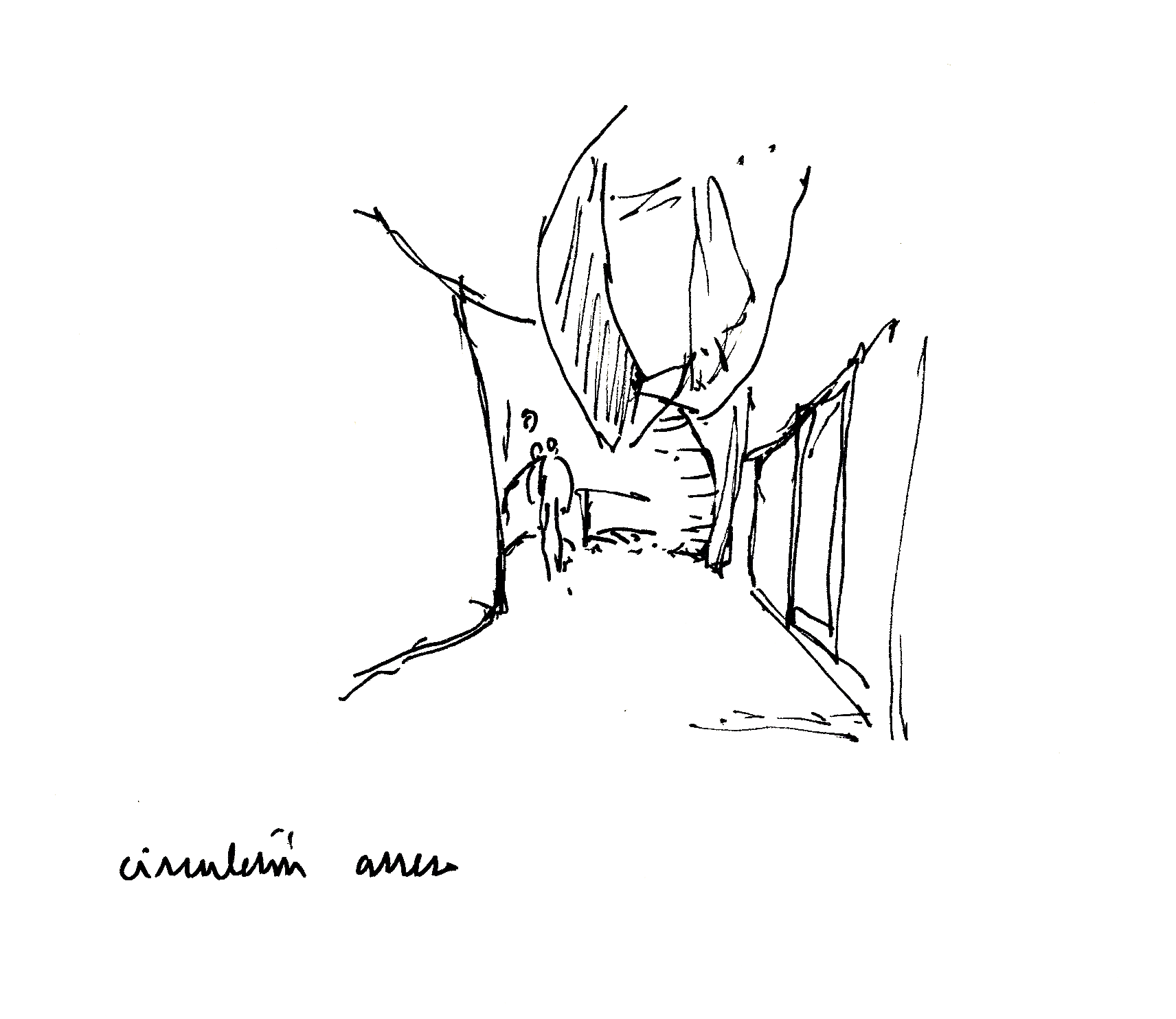LAND AND POETICS SHAPING A FEMININE TYPE OF ARCHITECTURE.
Interview with Cazú Zegers.
Words by María D. Martínez.
In 1912, US architect Marian Lucy Mahony, apart from being the second woman receiving her title from the MIT, she built a new concept across modern urbanism’s history together with her husband Burley Griffin: the design of the city of Canberra, capital of Australia, leading the notion that a modern civilisation has to live in sync with nature. It doesn´t come as a surprise that historians left her out of the picture when addressing the project.
Now, the profile of a genuine type of architecture that follows feminine values propels the industry thanks to unique voices like Cazú Zeger’s. Philosophy, poetry, highly conceptual arguments, art and sustainability shape the strong architectural vision of the Chilean.

Portrait of Cazú Zegers. Photography: Pedro Quintana.
M.D.: IN 2016 YOU RECEIVED THE HONORABLE MENTION AT THE ARCVISION AWARDS WHICH RECOGNISE WOMEN IN THE FIELD OF ARCHITECTURE. THEY WERE EVEN REFERRED TO AS “THE FEMALE PRITZKER’S”. DO YOU BELIEVE IT IS ACTUALLY NECESSARY TO CREATE A SPECIFIC AWARD TO APPRECIATE THE ROLE OF WOMEN IN THE INDUSTRY?
C.Z.: I actually don’t think there has to be a different category within architecture such as “female architecture”. Architecture doesn’t have gender. But I do think the Awards have done a remarkable job in giving visibility to women in the industry, and that is highly appreciated.
That reminds me of Arthur Rimbaud and the second letter to his brother in A Season in Hell. There he underlines how annoying the poets of his time were, those who he considered to have sold themselves to the system and to have abandoned their role as “visionaries”. In the text, he mentions that such types of poets will only exist when women abandon the constant servitude to men and free themselves from their chains. Women will be the ones who will create the unfathomed and the inconceivable, men will simply attend and celebrate.
I think that time has come, and it is an emergency to balance human development, leaving out this competitive, cumulative and extractive desire which comes directly from the masculine aspects of being. This is why we need to rebalance, learn to join in, to bring stability, to be respectful, to recover sacredness. Attributes I understand as feminine, not as an opposition to masculine, since there is no real gender in being, in fact we all have feminine and masculine attributes.
It is urgent to reconnect and balance both aspects, since the planet won’t resist other way. The human species have become the real virus for the planet. For me, the COVID pandemic is the antibody the Earth has created against our insensitivity.
M.D.: YOU PLACE YOUR PROJECTS AND YOUR VISION OF ARCHITECTURE WITHIN THE FRAME OF GEOPOETICS. THIS CONCEPT, ALMOST PHILOSOPHICAL, DOES SEEM DIFFICULT TO UNDERSTAND A PRIORI. HOW WOULD YOU DESCRIBE IT IN A MORE COLLOQUIAL WAY? WHAT IS THE ACTUAL GOAL OF THIS WAY OF CREATING?
C.Z.: That question goes straight to the point!
Geopoetry is a concept created by writer Keneth White in 1979. The concept was presented to me by a friend architect: Juan Pablo Almarza. But, actually, it had already been extensively developed by my teacher, the poet Godofredo Iommi, one of the founders of Amereida (Images 1 y 2). He based his concept on the famous words of German poet Friedrich Höderling: “Full of merits, but it is poetically how a man inhabits this earth” (VI, 25). This is also one of the statements that philosopher Martin Heidegger uses in his essay on Art and Poetry. In it, he talks about the origins of the work of art and the meaning of giving and assigning names in a poetic way.
So, in a “more colloquial” way, for me Höderling’s words talk about the creative potential of every human being. We all have within us that creative / spiritual condition, where naming gives things a way of “being”. The etymology of the word “poetry” comes from the Greek mosaic, poesis in Latin language. In Greek it means “the characteristics of the action of doing” and it refers to transforming thoughts into substance. For me it means that when you give something a name you are providing it with a real form of “being”. Following this line of thought, Geopoetry can be understood as the crossroads between land and words. In my case, between land and poetic-words.
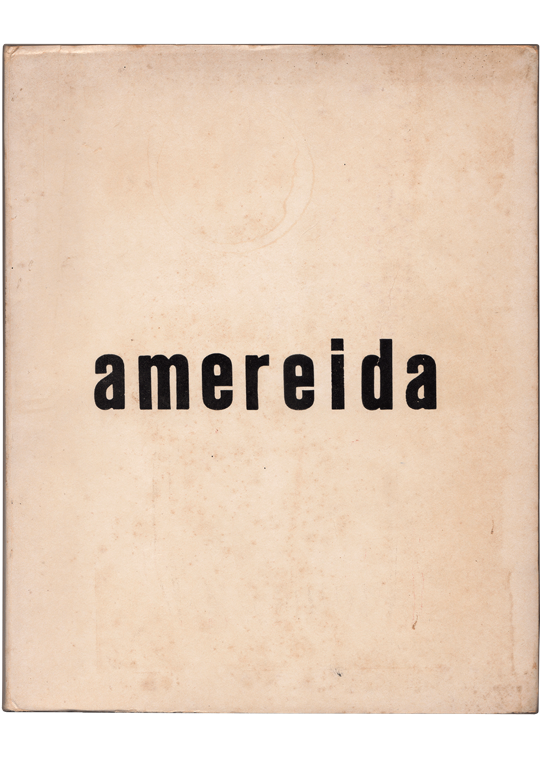
Image 1
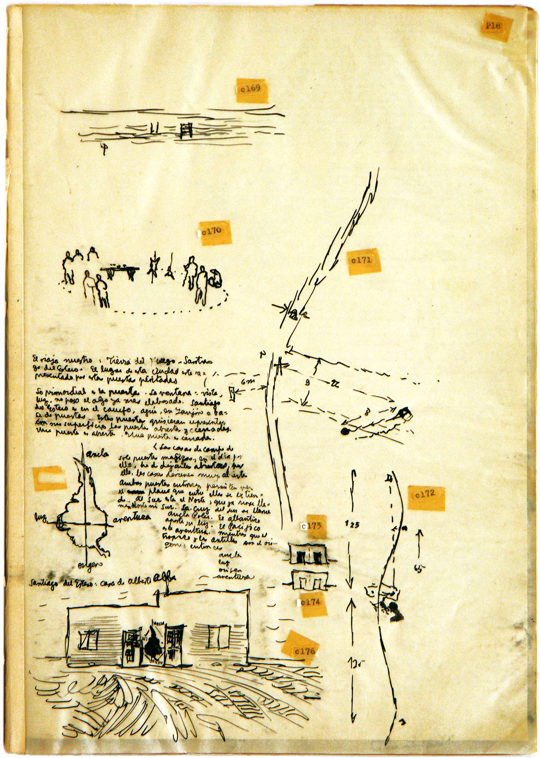
Image 2
Image 1: Cover of Amereida, Volume One, May 15th, 1967. Source: Tesis de Amereida.
Image 2: Santiago del Estero, Alberto Alba’s house; Alberto Cruz’s notebook p. 18; Amereida’s Trip 1965. Source: Historical Archive José Vial Armstrong © Escuela de Arquitectura y Diseño, Pontificia Universidad Católica de Valparaíso.
*Amereida, or the American Aeneid, is an epic poem that brings together the discovery of America and the Latin adventure of the Aeneid. It comes from the trip made by a group of poets, architects, designers, sculptors, philosophers and artists in 1965. As they travelled across the South American continent, from Tierra del Fuego to Santa Cruz de la Sierra in Bolivia, they wondered about the meaning of America, to then come to understand the purpose behind Amereida´s poem as a way of living and being American.
To give shape to the actual book, various texts, annotations, poems, letters, clippings and drawings of the group were compiled.
M.D.: YOUR THESIS “LIVING LIGHTLY AND PRECARIOUSLY” (HABITAR LEVE Y PRECARIO) BECOMES, IN YOUR OWN WORDS, “AN ARTISTIC PROPOSAL FROM LATIN AMERICA TO THE WORLD”. WHAT’S BEHIND THIS CONCEPT? WHAT IS LATIN AMERICA, AND CHILE IN PARTICULAR, SHOUTING TO THE REST OF THE WORLD WITH THIS PROPOSITION?
C.Z: (Audio). Living lightly and precariously speaks of a relationship, it is the way in which we relate and inhabit our territory and landscape. Based on Amereida’s thesis, it is suggested that America is a continent that “emerges as a gift”, as Columbus had been looking for India and he didn’t recognise it was a new continent when he arrived.
Amereida is an epic-foundational poem in which, emulating the Aeneid, it tells us to be in charge of our destiny and to build a new culture. This is so as not to continue imitating others, or to carry on with the nostalgia of a lost homeland, or to look for a different territory where to “recreate America”.
This means we need to create a new culture, to which I add: a new culture that inhabits almost without leaving a trace on the territory. Because “the land is to America what monuments are to Europe”. I came out with this premise in my first international talk at COARC in Barcelona, for the centenary of Gaudí.
“Living lightly and precariously” comes from living with what it’s at hand, generated by local processes, creating identity associated to the territory. In the words of naturalist Sergio Elortegui, professor at Andes Workshop, it’s a “bio-geopoetic” way of living.
It is a way of building through low technology and with a highly experiential involvement where “precarious” doesn’t mean poor but virtuous. And “light” comes from adding to the great natural monuments, not from imposing ourselves on them. This position was very clear to the original population of Latin America. So, honestly, I think it is the salvation of our planet, to return to a balance between men and environment, with technology serving us and not the other way round.
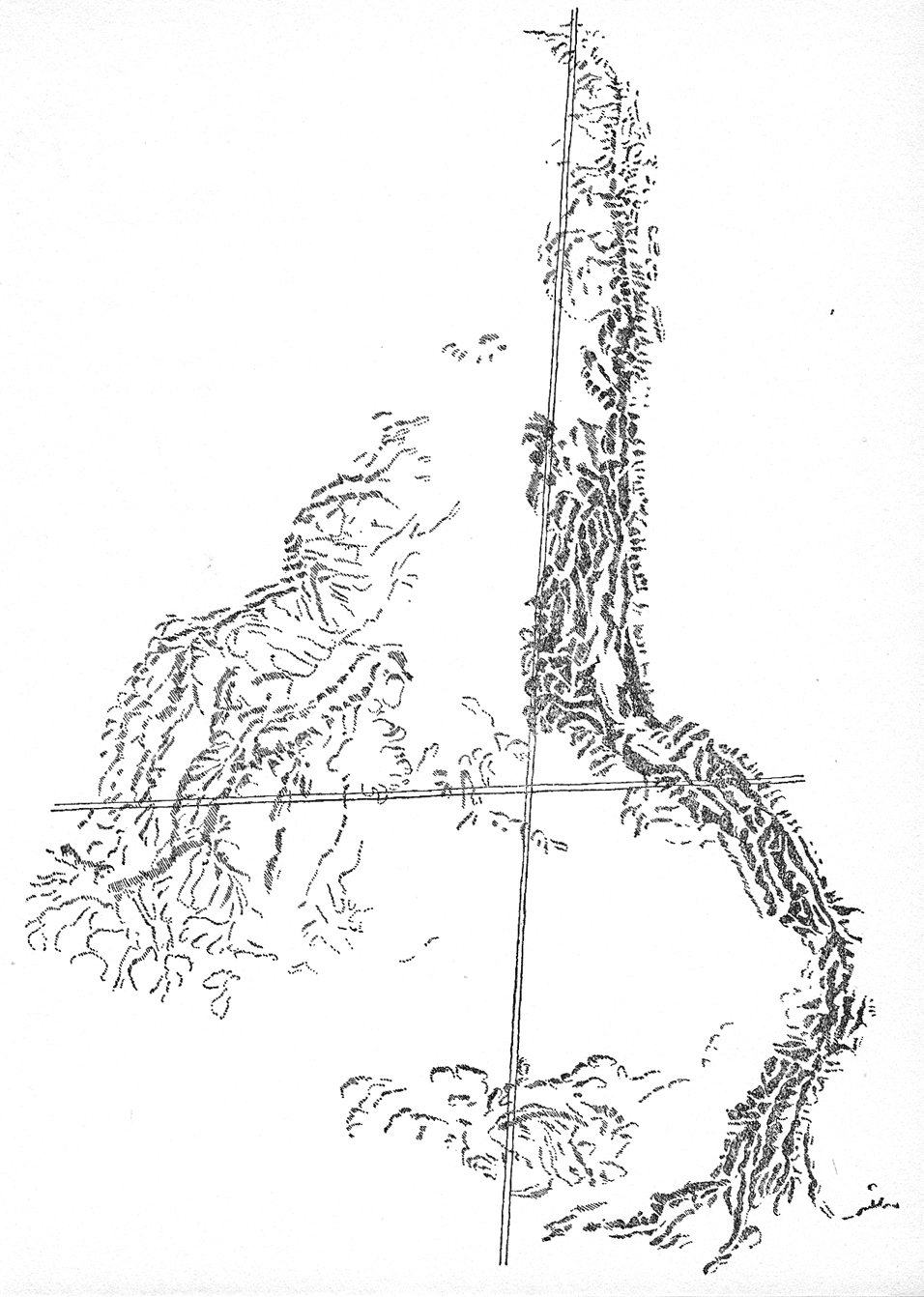

|
Audio: Listen to Cazú Zegers talking about her thesis “living lightly and precariously” and how this becomes an artistic proposition from Latin America to the world.
“Latin America has something to say to the world”. Drawing of Inverted America. Source: Tesis de Amereida.
M.D.: FOLLOWING THE ABOVE, COULD YOU TELL US ABOUT THE PROJECT BEHIND THE FOUNDATION AND CENTRE OF GEOPOETIC STUDIES “OBSERVATORIO DE LASTARRIA” AND HOW IT RELAUNCHED AS “FUNDACIÓN +1000)?
C.Z.: At the beginning of the 1980s, while I was studying architecture, I took three off-road motorcycle trips through Chile during my holidays. Those were 3 years in which I travelled Chile from continental end to end, through the mountains, the valley and the coast. In the 1980s Chile was still a vernacular, pre-development country, before the hydroelectric factories and the highway that connects Patagonia to the rest of continental Chile were created. This experience of touring Chile on a motorcycle, the precariousness of the trip where one barely takes a pair of clothing, a tent, and a couple of tanks of petrol, allowed me to deeply experience the territory. I always say that “the territory, the land got into my body / I am territory now”. This gave me a deep understanding of what is like to inhabit this place called Chile.
At the beginning of 2000 I had to return to continental Patagonia, and I was overwhelmed with the inability of the Chileans to understand the true value and identity of our country. This led me to try and open the eyes of political leaders, to try and influence in territorial planning. However, it was too early in time so my ideas were left as a great utopia. That utopian dream inherited from Godo (my professor) of what would happen if we were to leave Chile “underdeveloped” in order to dedicate ourselves to the creation of a natural reserve for the planet.
This dream led me to set up some encounters with friend artists and philosophers. We called ourselves: “Las novedades de la punta del cerro” (The news of the “get the hell out” group), because of the many times they told us to “get the hell out” with our ideas.
After a while, a relative of mine, Álvaro Flaño Amado, told me he had recently restored a large house from the early 20th century in Lastarrias (a patrimonial neighbourhood in Santiago de Chile), and asked me if I had any ideas of what to do with the place. I told him about our group of friends and how fascinating it would be to give a “home” to all the thoughts and projects we had in mind. At that time, we happened to meet the columnist Miguel Laborde and we decided to set up the “Observatorio de Lastarria” foundation at that house Álvaro had renovated, the Casa de Lastarrias. Miguel found out that the house was actually built by one of the architects from “Los Diez” (“The Ten”) an artistic movement from the beginning of the 20th century inspired by the same ideas of identity that inspired us as well.
Together with this group of friends, we founded the “Observatorio” based on three premises: What is Chile? Who are Chileans? What type of country do we want to build? And with this, the aim of the project would be built around geopoetry (Image 3). The investigation would be sustained across: territory, poetry, and the endemic products that come from this relationship (we used wine, due to its “mystical/spiritual” aspects, and it seemed to us that it was what spoke best about our identity). We spent five years doing all kinds of cultural activities around these three premises.
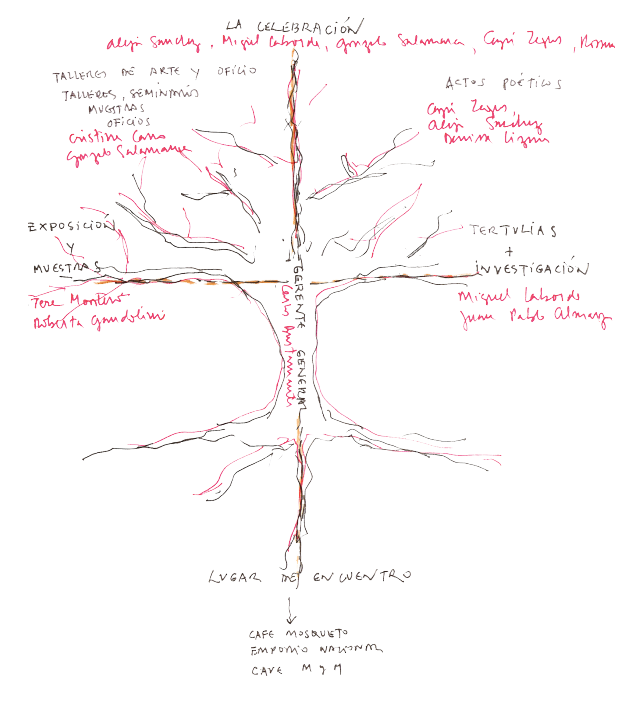
Image 3
Image 3: Foundation sketch with concepts to structure the geopoetic idea behind “Observatorio de Lastarria”. Source: Observatorio de Lastarria, sketch by Cazú Zegers.
In 2010, we decided to leave the building at “Casa de Lastarrias” for different reasons. The foundation continued to operate from an office at my architecture studio, but we were not longer hosting events and at the end of 2012 we decided it was time to put the project on hold until a new willpower arrived.
As an anecdote, what happened is that one day Georges Amar, Keneth White’s colleague from the Institute of Geopoetics, arrived at the “Observatorio”. He was surprised to find a place in Chile that was actually an Institute of Geopoetic Studies. That’s how we got connected to White himself.
The Institute of Geopoetics used to have an annual conference with all the associated institutes. So in 2014 I participated with a talk “Araucanía Capital City” (that name was Miguel’s idea, referencing the work I was carrying out with indigenous communities in the region of Araucanía). When I was presenting at that talk, which was quite successful, I realised I was stating the problem but that it was necessary to get involved and to start working under the motto of: “if you don´t like how things are, get to work and create better practices”. This tell us that we are all actually responsible and part of a place, community, country, territory, a planet. Later on, this assumption is what constituted the starting point for other projects like Pehuenche Route, Andes Workshop, or Santiago Capital Outdoor.
It was with this last project that I met the architect and athlete Canuto Errazuriz. With him, and thanks to his partner, we decided to create a new foundation. So that’s how the “Obsevatorio” evolved into the actual “Fundación +1000”, carrying on with the same initial ideas while amplifying the vision.
M.D.: WHAT ARE THE FUTURE PLANS OF YOUR STUDY TO KEEP SUPPORTING THIS TYPE OF ARCHITECTURE THAT IS KIND AND LOVING TO THE ENVIRONMENT?
C.Z.: We are really going for it and have managed to put together an agile, collaborative, transdisciplinary and “light” team. Just like a Tesla car. We are a “light and precarious” team that’s highly efficient and works freely and in a sustainable way.
Another professor of mine, Alberto Cruz Covarrubias (co-founder of Amereida and the School of Architecture) used to say that “one becomes an architect after 20 years of experience”. My study is now 30 years old and it is now when I feel prepared to answer these questions in a lucid, expanded-vision manner. We are now running lots of projects that are key to new ways of doing architecture and achieving balance.
At the moment we are creating an investigation centre called “Madera LAB” (Wood LAB), taking the concept of British architect Alex de Ritchter, who claims that “technified wood is the new concrete and the 21st century key material due to its environmental credentials”, among other characteristics.
M.D.: THE CONTRIBUTION OF WHICH OTHER FELLOW ARCHITECTS WOULD YOU HIGHLIGHT? ANY VISION YOU REALLY ADMIRE?
C.Z: That’s a tough question! I admire many people, I’m nurtured by many thoughts, I don’t want to name any in case I leave others out. But we all have something to contribute with and that is why I learn from everyone and from all disciplines. I believe the future is transdisciplinarity and collaborative systems.
So, to try and answer the question, scholars I’ve been directly influenced by would be: the school of thought from Godofredo Iommi, Manuel Casanueva, Amereida’s Thesis, Art and Poetry, Zaha Hadid, Paul Virilio, quantum physics, sacred geometry, the work of Lemi Ponifasio and lately Byung- Chul Han. The truth is I know I’m still leaving many out.
M.D.: SO, TO GIVE AN END TO OUR CHAT, WHICH OF THE MANY PROJECTS YOU’VE DEVELOPED IS THE ONE THAT IS STILL CLOSE TO YOUR HEART?
C.Z: I keep a special memory from each one, each of them has been a “Prototype in the Territory” (the title given to the monographic book published by ARQ, 2008) that has allowed me to make this deep reflection on inhabiting and building the world.
Starting with my first house, CALA house (Image 4), which I give the name of “thesis house” since that is when I started creating with this methodology of gesture, figure, shapes; in order to achieve a unique work that talks to the place where it has been built, it gives the place a way of “being”.
The questions raised by the CALA house are answered in full with Tierra Patagonia Hotel (Image 5), a project built through all these ideas on geopoetics and inhabiting a land in a loving way.
Image 4: CALA House. Sketch Cazú Zegers | Photography Cristina Alemparte.
“My thesis house starts from the observation, then the form and the word intersect to create a new, vernacular language, where the disassembling of the traditional shed is the defoliation of the flower. The house is located in the highest part of the land, between the emptiness of the lake and the serenity of the undulating countryside.”
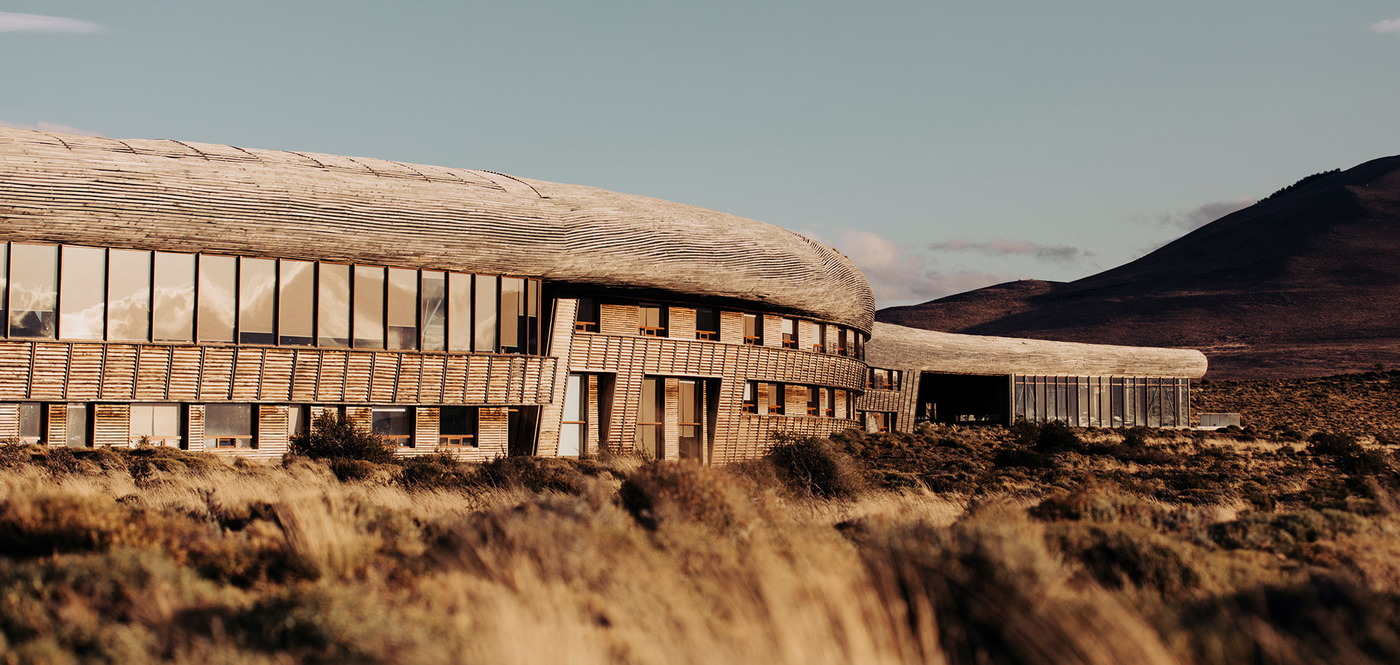
Image 5
Image 5: Tierra Patagonia Hotel. Photography Addison Jones.
“The gesture of the building arises from the shapes drawn by the wind, a natural element characteristic of the area. The form seeks not to break into the metaphysical landscape of the place, but to join. The image of the hotel is that of an ancient fossil of some prehistoric animal, stranded on the shore of the lake.”
Then, my own place, SOPLO house (Image 6 | 7), opens the way to novelty.
As of today, and after meeting the choreographer, dancer and theatrical director Lemi Ponifasio (with whom I collaborated artistically), I understood that architecture is a connection of systems across space and around the “emptiness” of a land.
This can be the emptiness of a stage, the emptiness that sustains the different parts of a house, or the emptiness surrounding the territory; but architecture is always born from a relationship. The relationship we create as humans, bonds and acts which architecture gives shape in a material or an intangible way; from a small cabin to a whole territory like the mountain buttress of Santiago. It is not about building a container to live in, but about creating shapes from our relationships with the environment.
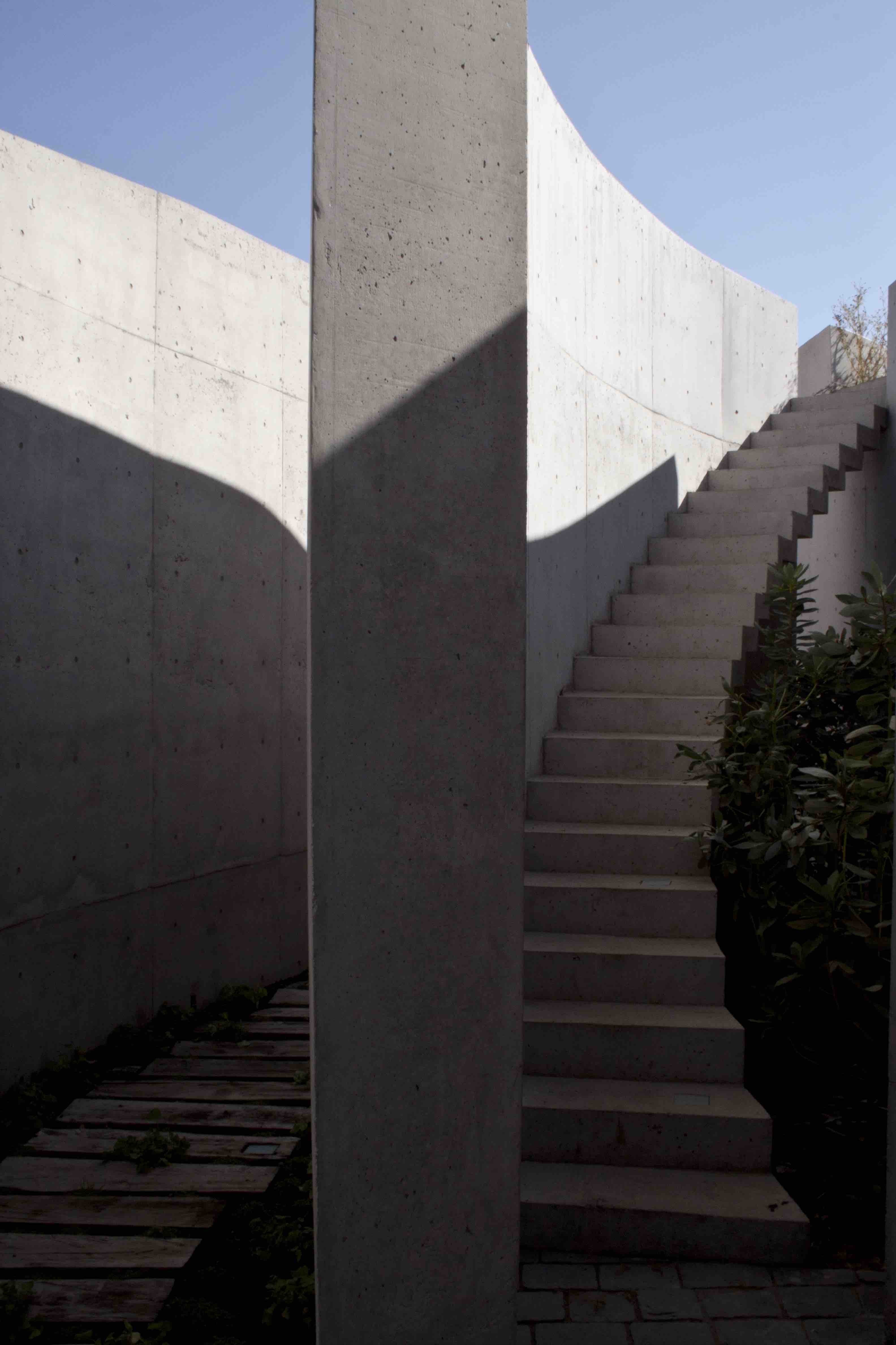
Image 7
Image 6: SOPLO House. Sketch Cazú Zegers
Image 7: SOPLO House. Photography Isabel Fernández
“The breeze (soplo) doesn’t have doors nor windows, it follows the relieves of the valley that surrounds the condor. The steps created walls, language trails, concrete clouds that raise the house from the Manquehue hill. Its concave crystals bring the city to the parlour. Housing attached to Cazú, Clara and other residents, a feminine and democratic form of art. This is the valley of female liberation, flexible spaces, enlargement of the soul without walls or restrictions.”


